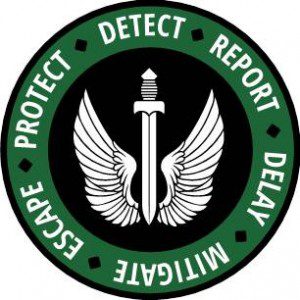
- School Safety and Security Overview
- School Safety and Security Agenda
- Common Sense School Safety and Security Take-Aways
- Ten Key Benefits of School Safety and Security
How to evaluate your environment (home, workplace, public places you frequent) and use this information to develop a plan of action for any given event.
A method of developing the habits of increased awareness of potential threats to your person or your classroom and how to appropriately plan to deal with them.
- Establish may ways to evacuate a building.
- Establish positive entry controls.
- Deal with potentially violent individuals.
- Learn about bomb threats and what they really mean for schools.
- Understand how to use your building as an aid in protection during an event.
Onsite security evaluation and assessment.
This requires an unfettered access day to allow our team to examine physical and operational security aspects, methods, procedures and terrain association. This Extensive application will create a safety and security portfolio with recommendations for your school to implement. It includes:
i. Onsite survey with video and images
ii. Terrain feature survey for evacuation routes
iii. Drone imagery (weather permitting)
iv. Assessment of current procedures
v. Recommendations for further procedures to increase security signature
Staff training for key safety and security measures
a. This can be from ½ to a full day of training for the entire staff which will include
i. Emergency simulations
ii. Active shooter protocols and response
iii. Bomb threat response
iv. Evacuations for both active shooter and fire
v. Shelter-In Place Operations
vi. Stand To, Modified and Full Lockdowns
Security and Safety Team Training
a. This program targets your individual team to give them intensive training so they can continue to review and assess potential threats and create your own responses to emerging situations.
i. SASQ Method of Threat Assessment and Evaluation
ii. Development of Harbor Points
iii. Establishing communication protocols for emergencies
iv. Establishing Relationships with local first responders
v. Prepare protocols and SOPs for emergency operations and
Recovery operations after an event
We can also customize your program with your specific needs. As we know, each school will have its own set of limitations, potential threats and ability to react to them. With this three-pronged approach we help schools intelligently and systematically identify what are potential threats and develop onsite protocols and habits to help eliminate or mitigate them.
Learn to build habits that will keep you aware of your surroundings and alert you to potential threats.
- Understand how to use a building’s entrances and exits to help you plan to evacuate during a crisis.
- Maintain awareness through pre-planning.
- Understand when and where most events occur in public and how to avoid them.
- Build the habit of creating options for yourself, wherever you are.
Understanding how telephones can undermine your personal identity and security.
- Protect your identity while on the phone.
- Learn how to effectively communicate with emergency personnel.
- Use your phone as a device to serve you and not the bad guy!
- Be aware of the intricacies of electronic communication and how they can affect your safety.
Understanding and Dealing with threats.
- Learn the difference between direct and indirect threats.
- Develop a response option for veiled threats.
- Assessing conditional and instrumental threats.
- What to do with expressive and emotional threats.
Safety in the Classroom
- Protecting food and beverages.
- Dealing with student initiated violence.
- Dealing with adult initiated violence.
- Develop plans to help protect your classroom.
Lockdowns and Evacuations.
- How to react to full lockdowns and build options for your class.
- How do modified lockdowns work and how can they best serve you.
- Escaping and evading.
- Discuss and develop final options at the door.
OVERALL
- Know how to react to an active shooter scenario
- Learn the methods to protect yourself and use common sense during bomb threats.
- Understanding what a threat really is and how to react to it.
- Learn about digital security for your online presence.
- Learn the basics of survival and how that baseline knowledge can serve you in an emergency.
- Create a habit of awareness, especially in public areas.
- Learn the importance of knowing entrances and exits and how to effectively use them to your advantage.
- Learn the method of true evacuations while using cover and concealment to protect you and your students en-route to a safe location.
- Learn strategies for self-protection in public areas such as hotels, concerts, planes and restaurants.
- Learn to keep all of these situations in perspective to create realistic and common sense options.
Teachers will…
- Develop personal safety habits.
- Understand and apply methods to increase your awareness.
- Understand the nature of threats.
- Learn how to scan your environment for potential threats.
- Prevent giving away critical information about yourself and family.
- Learn where to pay attention for potential threats in public places.
- Learn to protect your digital information.
- Maintain a level of awareness in all situations.
- Concerning entrances and exits: how to monitor and use them for your own protection.
- Next-day strategies to help you assess your personal habits and increase your individual security abilities. From maintaining awareness to understanding when and where you would evacuate an area, these strategies will help you increase your safety anywhere in the world.
- Look at your work environment (classroom and school) through the eyes of a potential threat…. Understand how to capitalize on the strengths of your current building and classroom to use to your advantage during a critical event.
- Learn how to choose and explore primary, secondary and even tertiary escape routes from your classroom and building…. Predetermined routes will help you better protect yourself and students.
- Understand how protected your evacuation routes are …. Create a Go-Bag you can use to immediately leave with your students for better capabilities while evacuating.
- One way in, many ways out! …. Understanding the importance of positive entry controls can help your overall safety plan for both classroom and school building.
- Understanding the nature of threats …. Threats are often designed to create fear and disrupt the school day, know how to tell the difference!
- Understand how to challenge an unauthorized person …. When we encounter an unauthorized person in the building, how should we best approach the situation? How do we prevent escalation and protect ourselves in the process?
- Understand bomb threats …. Be able to effectively scan your area and efficiently evacuate (if needed) while also helping responding emergency personnel!
- Keeping your digital persona safe! …. Learning how to protect yourself online for peace of mind and security from fraud and identity theft .
- Avoid potential threat areas in public places …. Know where to be and when to be there and most importantly what to avoid to stay safe in public places.
- Understand your options during lockdowns and other emergency drills …. It is so much more that locking doors and staying silent, learn what else you can do to protect yourself and students.
